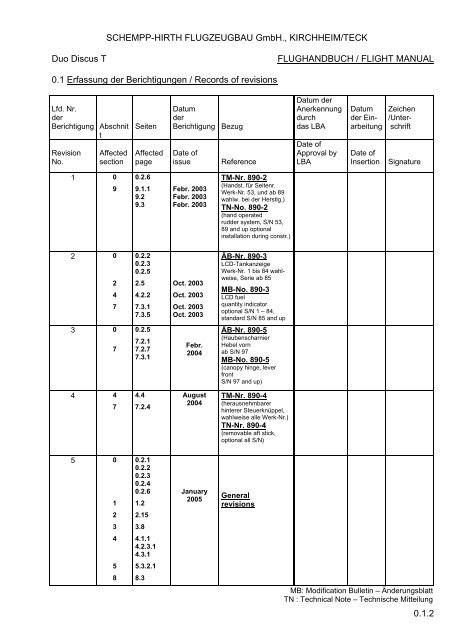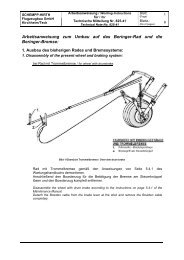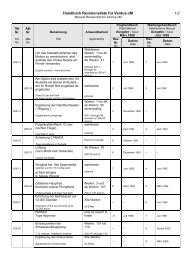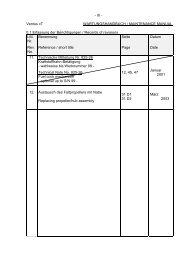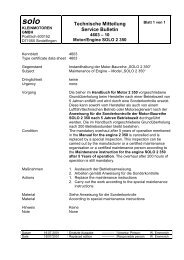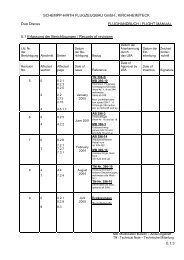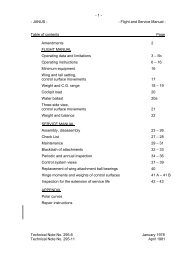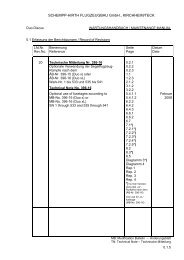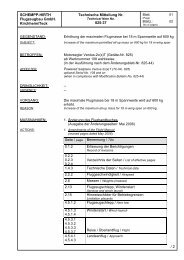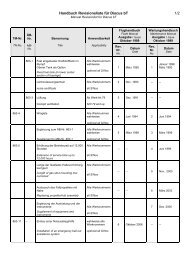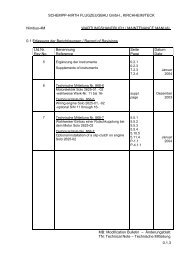SCHEMPP-HIRTH FLUGZEUGBAU GmbH., KIRCHHEIM/TECK Duo ...
SCHEMPP-HIRTH FLUGZEUGBAU GmbH., KIRCHHEIM/TECK Duo ...
SCHEMPP-HIRTH FLUGZEUGBAU GmbH., KIRCHHEIM/TECK Duo ...
You also want an ePaper? Increase the reach of your titles
YUMPU automatically turns print PDFs into web optimized ePapers that Google loves.
<strong>SCHEMPP</strong>-<strong>HIRTH</strong> <strong>FLUGZEUGBAU</strong> <strong>GmbH</strong>., <strong>KIRCHHEIM</strong>/<strong>TECK</strong><strong>Duo</strong> Discus TFLUGHANDBUCH / FLIGHT MANUAL0.1 Erfassung der Berichtigungen / Records of revisionsLfd. Nr.derBerichtigung AbschnittRevisionNo.AffectedsectionSeitenAffectedpageDatumderBerichtigungDate ofissueBezugReferenceDatum derAnerkennungdurchdas LBADate ofApproval byLBADatumder EinarbeitungDate ofInsertionZeichen/UnterschriftSignature1 090.2.69.1.19.29.3Febr. 2003Febr. 2003Febr. 2003TM-Nr. 890-2(Handst. für Seitenr.Werk-Nr. 53, und ab 89wahlw. bei der Herstlg.)TN-No. 890-2(hand operatedrudder system, S/N 53,89 and up optionalinstallation during constr.)2 02470.2.20.2.30.2.52.54.2.27.3.17.3.5Oct. 2003Oct. 2003Oct. 2003Oct. 2003ÄB-Nr. 890-3LCD-TankanzeigeWerk-Nr. 1 bis 84 wahlweise,Serie ab 85MB-No. 890-3LCD fuelquantity indicatoroptional S/N 1 – 84,standard S/N 85 and up3 070.2.57.2.17.2.77.3.1Febr.2004ÄB-Nr. 890-5(HaubenscharnierHebel vornab S/N 97MB-No. 890-5(canopy hinge, leverfrontS/N 97 and up)4 474.47.2.4August2004TM-Nr. 890-4(herausnehmbarerhinterer Steuerknüppel,wahlweise alle Werk-Nr.)TN-Nr. 890-4(removable aft stick,optional all S/N)5 0120.2.10.2.20.2.30.2.40.2.61.22.15January2005Generalrevisions33.844.1.14.2.3.14.3.155.3.2.188.3MB: Modification Bulletin – ÄnderungsblattTN : Technical Note – Technische Mitteilung0.1.2
<strong>SCHEMPP</strong>-<strong>HIRTH</strong> <strong>FLUGZEUGBAU</strong> <strong>GmbH</strong>., <strong>KIRCHHEIM</strong>/<strong>TECK</strong><strong>Duo</strong> Discus TFLIGHT MANUAL1.2 Certification basisThis non-self-launching powered sailplane, model designation„<strong>Duo</strong> Discus T“has been approved by the Luftfahrt-Bundesamt (LBA) in compliance with “JAR”,Part 22 effective on October 28, 1995 (Change 5 of the English Original Issue).The LBA Type Certificate is No. 890 and was issued on21.12.2001Category of Airworthiness:UTILITYThe Noise Certificate is based on the„Aircraft Noise Protection Requirements „ (LSL), Revision of January 1, 1991and includes the supplement dated April 6, 2000.January 2005Revision 5 1.2
<strong>SCHEMPP</strong>-<strong>HIRTH</strong> <strong>FLUGZEUGBAU</strong> <strong>GmbH</strong>., <strong>KIRCHHEIM</strong>/<strong>TECK</strong><strong>Duo</strong> Discus T FLIGHT MANUAL2.15 Limitations placardsMAX. PERMITTED ALL-UP WEIGHT (MASS): 1543 lb / 700 kg Max. permitted speedMAXIMUM PERMITTED SPEEDS (IAS) : km/h kt mphNever exceed speed 250 135 155Rough air speed 180 97 112Maneuvering speed 180 97 112Aerotowing speed 180 97 112Winch launching speed 150 81 93Landing gear operating speed 180 97 112For power plant extension/retraction 110 59 68With ignition ON 125 67 78Power plant extended speed 160 86 99PERMISSIBLE MINIMUM SPEED (IAS):For power plant extension/retraction 90 49 56Altitude[m]010002000300040005000600070008000900010000V NE(IAS)km/h kt mph250250250241229217205194183172162135135135130124117111105999387155155155150142135127121114107101SEATLOADfrontseat loadrearseat loadFIN TANK EMPTIEDLOAD ON THE SEATS(crew incl. parachutes)TWO PERSONSmin. max.70*kg154*lb110*kg243*lbatchoice110*kg243*lbONE PERSONmin. max.70*kg154*lb110*kg243*lbFor front seat loads below placarded minimumrefer to Flight Manual, section 6.2Fuel at kg lb Ltr. US. Gal. IMP. Gal.maximumseat load 12 26.5 16 4.23 3.52fin tank installedBallast in fin tank is dumptedsimultaneously with wing tanksOPENEDCLOSEDSEATLOADfrontseat loadrearseat loadFIN TANK FILLEDLOAD ON THE SEATS(crew incl. parachutes)TWO PERSONSmin. max.100*kg220*lbatchoice110*kg 100*kg243*lb 220*lb110*kg243*lbFor front seat loads below placarded minimumrefer to Flight Manual, section 6.2Fuel at kg lb Ltr. US. Gal. IMP. Gal.maximumseat load 12 26.5 16 4.23 3.52fin tank not installedONE PERSONmin. max.110*kg243*lb*) As the actual minimum or maximum load on the seatsof this "<strong>Duo</strong> Discus T" (to which this manual refers)may differ from these typical weights, the placardsin the cockpit must always show the actual weights,which are also to be entered in the log chart - see section 6.2.LOAD ON THE SEATS(crew incl. parachutes)SEAT LOAD TWO PERSONS ONE PERSONmin. max. min. max.front 70* kg 110* kg 70* kg 110* kgseat load 154* kg 243* lb 154* lb 243* lbWEAK LINK FOR TOWINGmax. 910 daN (2006 lb)Nose wheel :Main wheel :Tail wheel(if installed) :TIRE PRESSURE3.0 bar (43 psi)4.0 bar (57 psi)3.0 bar (43 psi)rear at 110* kgseat load choice 243* lbLoads of less than the above minimum must beraised by using trim ballast - see instructions givenin section 6.2 of the Flight Manual.Fuel at kg lb Ltr. US. Gal IMP. Galmaximumseat load 12 26.5 16 4.23 3.52Note: Further placards are shown in the Maintenance Manual.January 2005 LBA-appr.Revision 5 2.15
<strong>SCHEMPP</strong>-<strong>HIRTH</strong> <strong>FLUGZEUGBAU</strong> <strong>GmbH</strong>., <strong>KIRCHHEIM</strong>/<strong>TECK</strong><strong>Duo</strong> Discus TFLIGHT MANUAL3.8 Fire• CLOSE fuel shut-off valve• Master switch “OFF”• Ignition “OFF”Leave power plant in extended position!WARNING:Discontinue flight and land immediately!Avoid any maneuvers causing a high stressing ofthe fuselage !January 2005LBA-app.Revision 5 3.8
<strong>SCHEMPP</strong>-<strong>HIRTH</strong> <strong>FLUGZEUGBAU</strong> <strong>GmbH</strong>., <strong>KIRCHHEIM</strong>/<strong>TECK</strong><strong>Duo</strong> Discus TFLIGHT MANUALSection 44. Normal operating procedures4.1 Introduction4.2 Assembly4.2.1 Rigging and de-rigging4.2.2 Refueling4.2.3 Power plant, removal and re-installation4.3 Inspectionsa) Daily inspectionb) Inspection after re-installing the power plant4.4 Pre-flight inspection4.5 Normal procedures and recommended speed4.5.1 Methods of launching4.5.2 Take-off and climb4.5.3 Flight(including in-flight engine stop / start procedures)4.5.4 Approach4.5.5 Landing4.5.6 Flight with water ballast4.5.7 High altitude flight4.5.8 Flight in rain4.5.9 AerobaticsJanuary 2005Revision 5 4.1.1
<strong>SCHEMPP</strong>-<strong>HIRTH</strong> <strong>FLUGZEUGBAU</strong> <strong>GmbH</strong>, <strong>KIRCHHEIM</strong>/<strong>TECK</strong><strong>Duo</strong> Discus TFLIGHT MANUAL4.2.3 Removal and re-installation of the power plantIn order to allow the operation of the “<strong>Duo</strong> Discus T" in “plain sailplaneconfiguration", its power plant is quickly removable.The following components may be removed:• Engine with propeller• Power plant battery, located at the cockpit transverse steel tubeframe (unless needed for the avionics)The maximum saving in weight is approx. 34 kg (75 lb).The influence on the c/g position is described in section 6 of the“<strong>Duo</strong> Discus T” Maintenance Manual.Whenever the power plant is removed/re-installed, the empty mass c/gposition must be re-determined and, together with further data, be enteredin the weight & balance log sheet by a licensed inspector.Removing the power plant• Remove power plant battery from transverse frame(unless needed for the avionics)• Pull off fuel line and impulse line from diaphragm pump• Detach engine wiring by disconnecting 6 wires from the terminaland 3 wires from the ignition control at the front former inside theengine bay – make a note of the correct position of each cable, seealso maintenance manual Diagram 9a respectively Diagram 9b.• Remove screw between lower and right cooling baffle• Remove decompression valve actuating lever andinterconnecting link (see page 4.2.3.3)• Remove the nuts from the four bolts attaching the engine tothe pylon (see page 4.2.3.3)• Disconnect cooling baffle from port side of front cylinder head• Disconnect arresting wire from either pylon side• Lift engine (with prop) free from pylonJanuary 2005LBA-app.Revision 5 4.2.3.1
<strong>SCHEMPP</strong>-<strong>HIRTH</strong> <strong>FLUGZEUGBAU</strong> <strong>GmbH</strong>., <strong>KIRCHHEIM</strong>/<strong>TECK</strong><strong>Duo</strong> Discus TFLIGHT MANUAL5.3.2 Flight polarAll values shown below refer to MSL (0 m) and 15° C (59° F).a) Power plant retracted (or removed)*) Values are measured 1994 by Idaflieg/DLR.All-up weight (mass) 609 kg 700 kg1343 lb 1543 lbWing loading 37.1 kg/m² 42.7 kg/m²7.6 lb/ft² 8.7 lb/ft²Minimum rate of sink 0.58 m/s 0.62 m/s114 fpm 122 fpmBest L/D 45 45at a speed of100 - 103 km/h54 - 56 kt62 - 64 mph*)107 - 110 km/h58 - 60 kt66 - 69 mphb) Power plant extended – iginition switched OFF(engine not running)All-up weight (mass) 536 kg 700 kg1182 lb 1543 lbRate of sink 1.4 m/s 1.6 m/s276 fpm 315 fpm95 km/h 105 km/hat a speed of51 kt57 kt59 mph 65 mphBest L/D ( - ) 19 18Power plant extended – maximum power appliedAll-up weight (mass) 630 kg1389 lbBest rate of0.99 m/sclimb195 fpm90 km/hat a speed of49 kt56 mph700 kg1543 lb0.80 m/s157 fpm95 km/h51 kt59 mphA level flight attitude is attained at a speed V H = 115 km/h (62 kt, 71 mph).January 2005Revision 5 5.3.2.1
<strong>SCHEMPP</strong>-<strong>HIRTH</strong> <strong>FLUGZEUGBAU</strong> <strong>GmbH</strong>, <strong>KIRCHHEIM</strong>/<strong>TECK</strong><strong>Duo</strong> Discus TFLIGHT MANUAL8.3 Alterations or repairsAlterationsAlterations on the approved model, which might affect its airworthiness, must bereported to the responsible airworthiness authorities p r i o r to theiraccomplishment.The authorities will then determine whether and to what extent a “supplementaltype approval” is to be conducted.In any case, the manufacturer’s opinion about the alteration(s) must beobtained.This ensures that the airworthiness does not become adversely affectedand/or enables the aircraft owner/ operator to demonstrate at any time that thepowered sailplane concerned complies with an LBA-approved version.Amendments of the LBA-approved sections of the Flight- and/or MaintenanceManual must in any case be approved by the Luftfahrt Bundesamt (LBA).RepairsAbbreviations:CFRP: carbon-fibre reinforced plasticGFRP: glas-fibre reinforced plasticBefore every take-off and especially after the powered sailplane has not beenused for a while, it should be checked on the ground as shown in section 4.3.Check for any sign of a change in the condition of the aircraft, such as cracks inthe surface, holes, delamination in the CFRP/GFRP structure etc.If there is any uncertainty whatsoever regarding the significance of damagediscovered, the “<strong>Duo</strong> Discus T" should always be inspected by a CFRP/GFRPexpert.There is no objection to minor damage - which does not affect the airworthinessin any way - being repaired on site.A definition of such damage is included in the “REPAIR INSTRUCTIONS" whichare found in the appendix to the “<strong>Duo</strong> Discus T" Maintenance Manual.Major repairs may only be conducted by a certified repair station having anappropriate authorization.January 2005Revision 5 8.3


